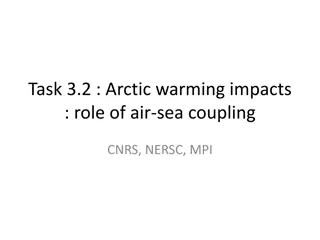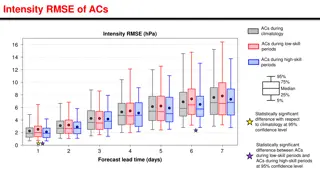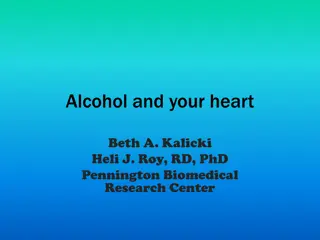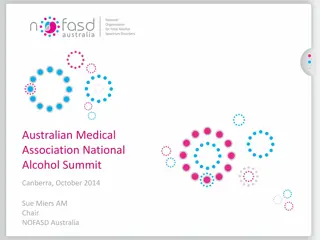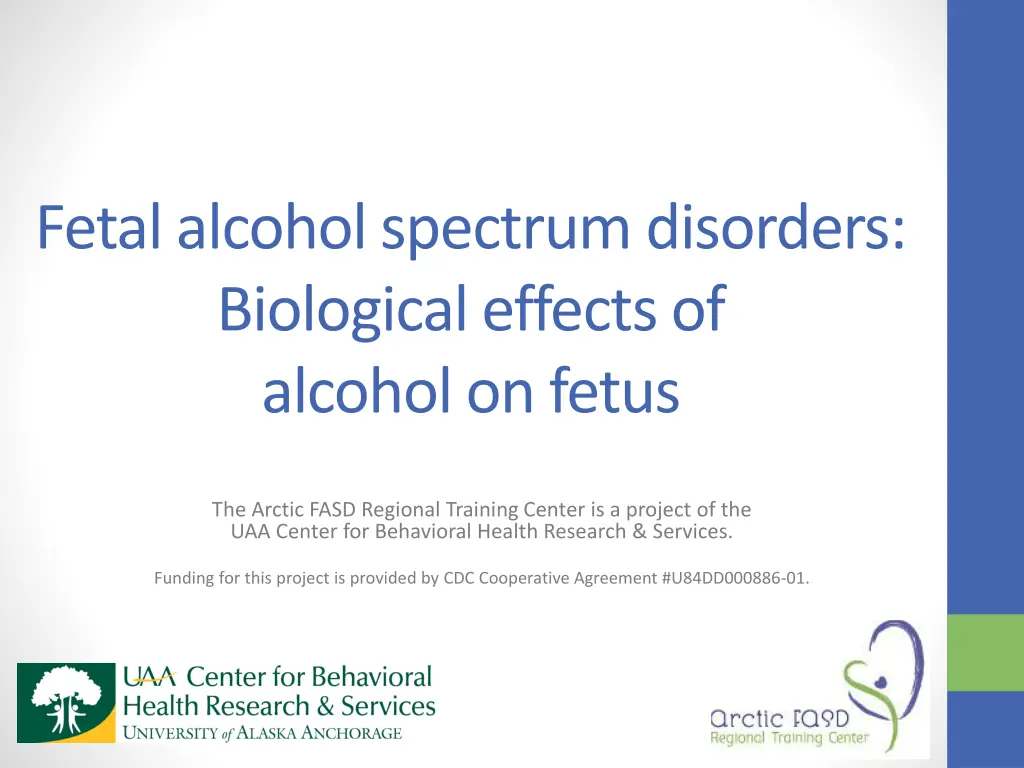
Understanding Fetal Alcohol Spectrum Disorders
Explore the biological effects of alcohol on the fetus, including alcohol metabolism, birth defects, neurobehavioral effects, and the impact on the developing nervous system. Learn about the distribution of alcohol, placental effects, metabolism and elimination, and neuromorphological birth defects associated with alcohol use. Discover the implications of prenatal alcohol exposure on the brain and its various susceptible areas.
Download Presentation

Please find below an Image/Link to download the presentation.
The content on the website is provided AS IS for your information and personal use only. It may not be sold, licensed, or shared on other websites without obtaining consent from the author. If you encounter any issues during the download, it is possible that the publisher has removed the file from their server.
You are allowed to download the files provided on this website for personal or commercial use, subject to the condition that they are used lawfully. All files are the property of their respective owners.
The content on the website is provided AS IS for your information and personal use only. It may not be sold, licensed, or shared on other websites without obtaining consent from the author.
E N D
Presentation Transcript
Fetal alcohol spectrum disorders: Biological effects of alcohol on fetus The Arctic FASD Regional Training Center is a project of the UAA Center for Behavioral Health Research & Services. Funding for this project is provided by CDC Cooperative Agreement #U84DD000886-01.
Road map for presentation Alcohol metabolism and pharmacology Birth defects associated with alcohol use Alcohol-induced injuries on developing nervous system Cellular response to alcohol exposure Biomedical mechanisms Neurobehavioral effects
ALCOHOL METABOLISM AND PHARMACOLOGY
Alcohol metabolism Alcohol introduced to stomach Absorption occurs rapidly Woman takes a drink of alcohol Peak blood alcohol level about 1 hour after consumption Absorption depends on several factors E.g., food consumption, body mass Gender differences: women attain greater blood ethanol concentrations than men
Distribution of alcohol Compartmentalization Alcohol soluble in water Cell is 98% water Alcohol easily crosses cell membranes
Placental effects Placenta acts as selective barrier Alcohol passed from maternal to fetal blood
Metabolism and elimination Genetic variation May influence alcohol consumption Fetal metabolism Placenta does not metabolize ethanol well Early stages of development very susceptible to damage
NEUROMORPHOLOGICAL BIRTH DEFECTS ASSOCIATED WITH ALCOHOL USE
Prenatal alcohol exposure & the brain All areas of the brain are susceptible to damage E.g., cerebral cortex, cerebellum, cerebellar cortex, hippocampus Craniofacial malformations May be due to embryological changes in brain development
Fetal alcohol spectrum disorders (FASD) Fetal alcohol spectrum disorders Encompasses all diagnoses related to prenatal alcohol exposure Includes fetal alcohol syndrome (FAS) More than one of the features associated with FAS Not sufficient features to make a diagnosis of FAS Includes alcohol-related neurodevelopmental disorder (ARND) Individuals with FASDs have been exposed to alcohol in utero Secondary behavioral and cognitive effects result
ALCOHOL-INDUCED INJURIES ON THE CENTRAL NERVOUS SYSTEM (CNS)
Post-natal effects of alcohol use Alcohol exposure during first year of life Myelination and synapse formation continue through the first year of life Alcohol exposure can interfere with myelination Can result in alterations in gross motor movements Alcohol exposure during the lactating period Might be damaging to the nutritional intake of the infant
CELLULAR RESPONSE TO ALCOHOL EXPOSURE
Neurogenesis Neuron generation occurs rapidly in the developing embryo and fetus Alcohol exposure during this process affects cell numbers Can result in cognitive and behavioral deficits
Growth and differentiation Newly formed neurons undergo maturation or differentiation Each of these processes is vulnerable to the effects of ethanol exposure
Migration Cellular migration and migration of the cell Nerve growth factors Neurites are guided to their destinations following chemical substrates
Synaptogenesis Once at its destination, the neurite must form a synapse The connection between two nerves allows communication between the nerves Alcohol exposure during this period may disturb this process Togashi, Miyoshi, Sakisaka, Takai, &Takeichi, 2006
Apoptosis Programmed cell death Alcohol exposure may enhance apoptosis
Plasticity A nerve cell s ability to grow back and re- establish meaningful connections after it is damaged Mature neurons are less able to regenerate their function Getty Images Prenatal alcohol exposure seems to decrease plasticity
Neuromorphological and neurotropic effects Research has shown that alcohol can affect: Cell development Cell migration Cell processes Examples: Increases cell death Alters the growth of dendrites, affecting how the cell functions and communicates Disrupts neurogenesis and migration of neurons
Other biomedical mechanisms Prenatal alcohol exposure can affect the development of neurotransmitter receptors Affects the ability of nerves to function & communicate Prenatal alcohol exposure may affect the way a cell responds to received signals Catherine E. Myers. 2006 Memory Loss and the Brain
Cognitive and behavioral deficits Individuals with FAS may have low IQ Attention, memory, hyperactivity Learning impairments Not just related to academics, also language, visual-spatial skills Secondary conditions Mental health problems Disrupted school experiences Trouble with the law Confinement and/or incarceration Inappropriate sexual behavior Alcohol or other drug problems
Review Alcohol metabolism and pharmacology Birth defects associated with alcohol use Alcohol-induced injuries on developing nervous system Cellular response to alcohol exposure Neurobehavioral effects
Arctic FASD Regional Training Center www.uaa.alaska.edu/arcticfasdrtc arcticfasdrtc@uaa.alaska.edu 907.786.6381 The Arctic FASD Regional Training Center is a project of the UAA Center for Behavioral Health Research & Services. Funding for this project is provided by CDC Cooperative Agreement #U84DD000886-01.







